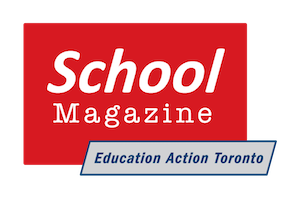Ontario’s 2020 budget – a “practical freeze” for education
School boards are strapped for cash, but the $31 billion 2020 Ontario Budget released last week by the Ford government isn’t going to help them much. According to economist Ricardo Tranjan, of the Canadian Centre for Policy Alternatives (CCPA) it’s essentially a “practical freeze” on spending- one that will likely continue for the next couple of years. There is an additional $200 per child up to 12 years old to cover pandemic related costs like buying computer equipment and internet access – $250 per child with disabilities. But overall, Mr. Tranjan says this is a stand-pat budget. He added that because of the COVID-19 related recession, “inflation projections are low” which reduces some added costs to school boards across the province.
Looking closer
There are some details that need a closer look. One is that the province says it’s “making $1.3 billion available for the education sector.” That’s only true if you understand it in the sense of passing it from one hand to another. Back in October Premier Doug Ford said the province was going all the way, to provide schools what they need to stay safe: “We have done absolutely everything, everything. “We’re sparing nothing. Every idea possible, we’re putting into the classrooms.”  Actually, much of that money, about $380 million by Ricardo Tranjan’s reckoning, comes from the federal government, with about $390 million coming from the province. He adds that there is another roughly $380 million due from Ottawa in January as the second instalment
Actually, much of that money, about $380 million by Ricardo Tranjan’s reckoning, comes from the federal government, with about $390 million coming from the province. He adds that there is another roughly $380 million due from Ottawa in January as the second instalment
The rest of it – up to $496 million – comes from school board reserves. This is not money provided by the province, but funds held by school boards to meet future obligations like health and safety requirements, according to NDP Education Critic, Marit Stiles. Half of that amount was already available to school boards; the province just upped the amount they could use, which she adds comes to about $91 million so far. Not only is this not new money, Ms. Stiles says, cutting into reserves “destabilizes the school boards for years ahead” making it appear that they have money to spend when they really don’t. “Will the province restore those funds?” she asks.
As for the woefully small $200 – $250 per child the province plans to spend, she agrees that a lot of families could use a hand, but why not invest that money in schools which could make more effective use of it. School boards could also make sure that the dollars are spent equitably in areas where the need for extra funds are highest.
The province says this money is for safety measures covering COVID-19 including : $100 million for more teachers to keep class sizes down; $90 million for personal protective equipment (PPE), $79 million for more custodian and cleaning supplies and $100 million “supporting a broad range of activities” which look a lot like the other initiatives it announced. School asked Ministry of Education media reps for details, but got no response. Elementary Teachers Federation of Ontario is concerned that there was no new money announced to pay for additional health and safety measures beyond this school year.
Is this even enough to cover current extra expenses? For example, the Toronto District School Board released a budget update recently noting the extra costs of running two school systems: one for kids attending class and one for those going to school online. It’s spent an additional $15 million on technology, cut into its reserves to pay for 280 more teachers and overspent its budget by $59 million to help special needs students. It was allotted $460 000 for PPE and cleaning supplies, but has spent $8 million. It still has to tackle a longstanding backlog of $3.5 billion in building repairs which include problems with ventilations systems.
Tax cuts in a time of COVID
Another aspect of the budget lost in the fog of numbers, is that it contains about $1 billion tax cuts, according to Ricardo Tranjan.1 This, at a time when the  government is projecting a deficit of $38. 5 billion for 2020-21 and $33. 1 billion for 2021-22. Most of this tax cut is meant to help out businesses, but for those that are struggling, they probably need relief rather than a tax cut for money they aren’t generating. For others, like the Loblaws grocery chain, that have seen revenues increase during COVID-19 by $824 Million (7.4 percent) – what’s the need for a tax cut?
government is projecting a deficit of $38. 5 billion for 2020-21 and $33. 1 billion for 2021-22. Most of this tax cut is meant to help out businesses, but for those that are struggling, they probably need relief rather than a tax cut for money they aren’t generating. For others, like the Loblaws grocery chain, that have seen revenues increase during COVID-19 by $824 Million (7.4 percent) – what’s the need for a tax cut?
Tax breaks just add pressure on future budgets to cut programs. It will be easy to forget, in 2021 or 2022, that the deficit over which the Tories are crying wolf as they cut services, includes of $1 billion in tax reductions. Add that to the fact that they aren’t keeping up with costs of education says Marit Stiles, when the pandemic is over “we’ll see more brutal and painful cuts.”
It certainly makes your head spin – a budget freeze during the most severe pandemic to hit the country in a century, all underscored by tax cuts for businesses. For a little while, Doug Ford put on a folksy performance as he claimed he was “sparing nothing to fight COVID-19. The money his government puts out says something different.
- Tax cuts include- in millions of dollars ( Table A3 Ontario Budget 2020):
- Reducing Employer health tax: $90 ( 2020-21); $360 (2021-22); $380 (2022-23)
- Reducing property tax for employers: $175 (2020-21); $385 (2021-22); $450 (2022-23)
- Property tax relief for small businesses: $35 (2020-21); $85 (2021-22); $110 (2022-23)
- Total (note that this includes all tax cuts): $315 (2020-21); $915 (2021-22); $995 (2022-23)

